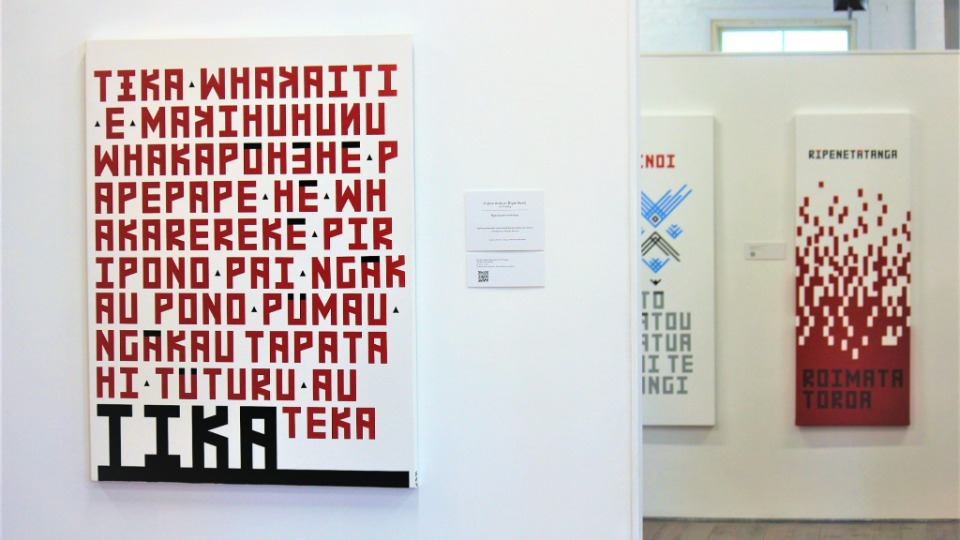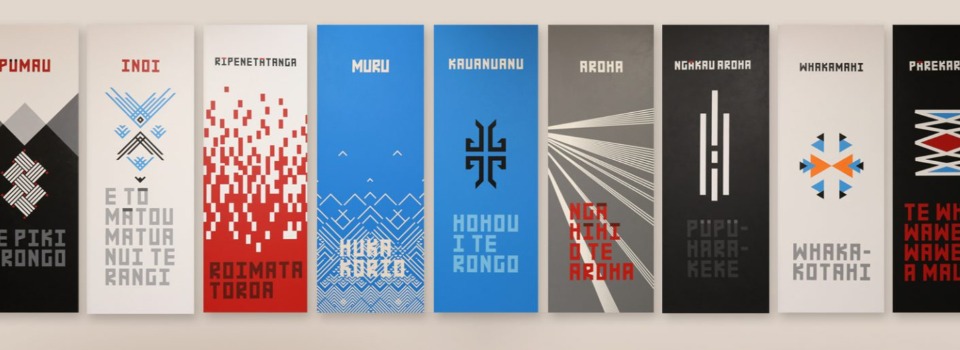52-year-old Whanganui resident Brigham Anderson (Ngāti Hauiti) is debuting his first art exhibition that combines traditional Māori tukutuku (geometric paneling art) with values from “The Family: A Proclamation to the World,” an official statement from The Church of Jesus Christ of Latter-day Saints.
Anderson’s exhibition titled “Ngā tukutuku o te kāinga,” (The home of tukutuku) opened at the Space Gallery in Whanganui on 1 December and will run through 18 December.
- Brigham-Anderson-at-his-exhibition-titled-Nga-tukutuku-o-te-kainga.-New-Zealand,-December-2021
- This-painting-is-titled-Faith---Whakapono-and-discusses-Anderson's-ideas-of-faith-as-an-ever-elusive-thing,-a-big-maze-that-you-continually-act-on-throughout-your-life.-The-tukutuku-panel-portraying-repentance-can-be-seen-to-the-side.-New-Zealand,-December-2021
- Anderson's-exhibition-includes-paintings-that-portray-faith,-goodness,-seasons-of-life-and-more.--New-Zealand,-December-2021
- A-view-of-some-of-the-tukutuku-panels-in-Anderson's-exhibition-that-discuss-the-family-values-of-forgiveness,-respect,-love,-compassion,-work-and-having-fun-together.-New-Zealand,-December-2021
| Temple Square is always beautiful in the springtime. Gardeners work to prepare the ground for General Conference. © 2012 Intellectual Reserve, Inc. All rights reserved. | 1 / 2 |
Anderson’s art is what he considers “faith based.” He quoted former president of the Church Brigham Young, who taught the principle that truth can be found everywhere, including in art and culture. He said the family values and truth that are found in Māori culture are similar to those found in the gospel, and so representing both in his art is important to him.
“There are lots of similarities in all people and religions, we have more in common then we have in differences, and I hope my pieces can bridge some of those gaps,” Anderson said. He hopes his paintings can be a reminder to live the gospel of Jesus Christ.
Although not a full-time artist, Anderson started focusing more time on his art during the pandemic which led him to create story-telling tukutuku paintings that symbolize principles and values from “The Family: A Proclamation to the World.”
When people see these paintings, Anderson hopes it leads the viewer to reflect on where they are in life and what improvements they can make in regards to their own family relationships and faith.
In nine of the tukutuku panels in the exhibition, he specifically highlighted these principles for families: faith, prayer, repentance, forgiveness, respect, love, compassion, work and having fun together.

One-painting-in-the-exhibition-is-titled-The-Teka-Tika-Continuum-which-portrays-the-relationship-between-lies-disguising-themselves-as-truth,-and-how-integrity-can-sometimes-be-a-lonely-road.-New-Zealand,-December-2021
One painting in the exhibition is titled "The Teka Tika Continuum" which portrays the relationship between lies disguising themselves as truth, and how integrity can sometimes be a lonely road. New Zealand, December 2021© 2021 by Intellectual Reserve, Inc. All rights reserved.Hours of research and planning went into designing, crafting and picking symbols he used in each painting to portray its story. The colours, shapes, lines, and Māori words he used to represent each principle all have special reasoning behind why he chose them.
In the faith panel painting, he included the word “rongo” at the bottom, which describes four of the five senses, excluding sight. With the increased influence of social media, Anderson said many rely too heavily on seeing to believe, but that isn’t how faith works. He used “rongo” to capture and symbolize the idea of not needing to see, to still exercise faith. "The word rongo also can mean peace, especially after a challenging time in our lives. The gospel of Jesus Christ brings that peace," he said.
The panel titled “Inoi,” portrays the principle of prayer. He used the colour blue to depict Heavenly Father because “it is a peaceful colour.” The words Anderson painted mean to call out to Heavenly Father and the shapes were meant to represent someone praying and God bestowing blessings upon them. Anderson said this painting symbolizes how the further a person seeks light, the more God will give them because “everything Heavenly Father does, is for our benefit.”

Nine-tukutuku-panels-of-Anderson's-exhibition-that-each-represent-a-family-value-found-in-The-Family-A-Proclamation-to-the-World.-They-are,-in-order-from-left-to-right,-faith,-prayer,-repentance,-forgiveness,-respect,-love,-compassion,-work-and-having-fun-together.-New-Zealand,-December-2021
Nine tukutuku panels of Brigham Anderson's exhibition that each represent a family value found in "The Family: A Proclamation to the World." They are, in order from left to right, faith, prayer, repentance, forgiveness, respect, love, compassion, work and having fun together. New Zealand, December 2021© 2021 by Intellectual Reserve, Inc. All rights reserved.Anderson based the forgiveness “Muru” panel on a talk by James E. Faust, former leader of the Church. In the talk, Faust told a tragic story about a group of Amish people who forgave and served the family of someone who had killed multiple Amish children. Anderson said that story of forgiveness inspired him to create shapes that look like the white foam on top of rapids to parallel the importance of forgiving and moving on.
“If you don’t forgive, you can get caught up in the rapids, and can drown, but as you forgive you move into more peaceful, calm water,” he said.
The colours, shapes and lines in his art are so exact, that many at first perceive his art to be digitally made and printed. But every piece of the exhibition he painted with acrylic paint. He said the precision of the paintings comes from his culture where they originally weaved tukutuku panels out of flax. If one part wasn’t done correctly, they would cut the flax off and start over completely.
Learn more about Brigham Anderson and his art here.